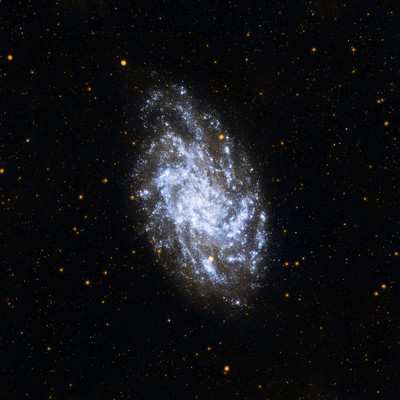NASA's Galaxy Evolution Explorer Mission marks its sixth
anniversary studying galaxies beyond our Milky Way through its
sensitive ultraviolet telescope, the only such far-ultraviolet
detector in space.

The mission studies the shape, brightness, size and distance of
galaxies across 10 billion years of cosmic history, giving
scientists a wealth of data to help us better understand the
origins of the universe. One such object is pictured here, the
galaxy NGC598, more commonly known as M33.
In these side-by-side images of M33, the ultraviolet image on
the left was taken by the Galaxy Evolution Explorer, while the
ultraviolet and infrared image on the right is a blend of the
mission's M33 image and another taken by NASA's Spitzer Space
Telescope. M33, one of our closest galactic neighbors, is about 2.9
million light-years away in the constellation Triangulum, part of
what's known as our Local Group of galaxies.
The Galaxy Evolution Explorer has two detectors: one in
far-ultraviolet, which reveals stars younger than about 10 million
years old, and another in near-ultraviolet, which detects stars
younger than about 100 million years old. The left ultraviolet
image shows a map of the recent star formation history of M33. The
bright blue and white areas are where star formation has been
extremely active over the past few million years. The patches of
yellow and gold are regions where star formation was more active
around 100 million years ago.

The ultraviolet image highlights the most massive young stars in
M33. These stars burn their large supply of hydrogen fuel quickly,
burning hot and bright while emitting most of their energy at
ultraviolet wavelengths. Compared with low-mass stars like our sun,
which live for billions of years, these massive stars never reach
old age, having a lifespan as short as a few million years.
Together, the Galaxy Evolution Explorer and Spitzer can see a
larger range of the full spectrum of the sky. Spitzer, for example,
can detect mid-infrared radiation from dust that has absorbed young
stars' ultraviolet light. That's something the Galaxy Evolution
Explorer cannot see. The combined image on the right shows in
amazing detail the beautiful and complicated interlacing of hot
dust and young stars. In some regions of M33, dust gathers where
there is very little far-ultraviolet light, suggesting that the
young stars are obscured or that stars farther away are heating the
dust. In some of the outer regions of the galaxy, just the opposite
is true: There are plenty of young stars and very little dust.

In the combined image, far-ultraviolet light from young stars
glimmers blue, near-ultraviolet light from intermediate age stars
glows green, near-infrared light from old stars burns yellow and
orange, and dust rich in organic molecules burns red. The small
blue flecks outside the spiral disk of M33 are most likely distant
background galaxies. This image is a four-band composite that, in
addition to the two ultraviolet bands, includes near infrared as
yellow/orange and far infrared as red.
Since its launch from a Pegasus rocket on April 28, 2003, the
Galaxy Evolution Explorer has imaged more than a half-billion
objects across two-thirds of the sky. Highlights over the past six
years include detecting star formation in unexpected regions of the
universe and spotting Mira, a fast-moving older star called a red
giant. Astronomers say that studying Mira's gargantuan cosmic tail
is helping us learn how stars like our sun die and ultimately seed
new solar systems.
The California Institute of Technology, in Pasadena, Calif.,
leads the Galaxy Evolution Explorer mission and is responsible for
science operations and data analysis. NASA's Jet Propulsion
Laboratory, also in Pasadena, manages the mission and built the
science instrument. The mission was developed under NASA's
Explorers Program managed by the Goddard Space Flight Center,
Greenbelt, Md. South Korea and France are the mission's
international partners.
 ANN's Daily Aero-Linx (04.15.24)
ANN's Daily Aero-Linx (04.15.24) Classic Aero-TV: 'No Other Options' -- The Israeli Air Force's Danny Shapira
Classic Aero-TV: 'No Other Options' -- The Israeli Air Force's Danny Shapira Aero-News: Quote of the Day (04.15.24)
Aero-News: Quote of the Day (04.15.24) Airborne 04.16.24: RV Update, Affordable Flying Expo, Diamond Lil
Airborne 04.16.24: RV Update, Affordable Flying Expo, Diamond Lil ANN's Daily Aero-Term (04.16.24): Chart Supplement US
ANN's Daily Aero-Term (04.16.24): Chart Supplement US





